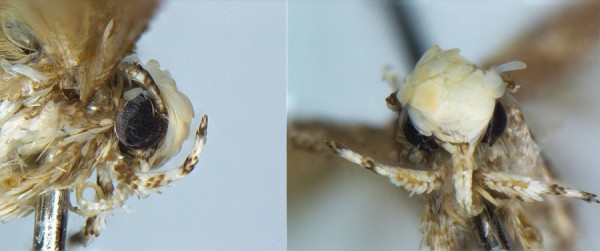By Ana Verayo, | January 22, 2017

This is a close up of the head of the holotype of the new species Neopalpa donaldtrumpi. (Dr. Vazrick Nazari/EurekAlert!)
A tiny moth with wings measuring only 0.4 inches has become the first species to be named after the 45th president of the United States, Donald Trump.
In a new study, scientists suggest that the yellow and white scales on top of the moth's head closely resemble Trump's hairstyle. Therefore, they named the moth Neopalpa donaldtrumpi, biologist Vazrick Nazari said.
Like Us on Facebook
The moth can be found living in Southern California and across Baja, California to Mexico. Nazari was examining research from the Bohart Museum of Entomology at the University of California when he noticed that a few specimens do not look the same as the other previously known species.
Nazari was investigating the North American moth family Gelechiidae that are also known as twirler moths. Nazari noted that its unique wing pattern and DNA barcode are evidence of it being a new undescribed species.
Shapes and certain folds including pouch-like structures have also been noted on N. donaldtrumpi's genitalia, making this a truly unique species, Nazari added. These moths are called twirler moths because they start twirling in circles when they get disturbed.
To date, this is the second twirler moth under the Neopalpa genus. The moth's family includes more than 4,830 species around the world.
Nazari was able to examine several N. donaldtrumpi specimens including one female and six males with their average body length the same as their wingspans, around 0.4 inches.
The most distinct feature of this tiny moth are the yellowish white scales on its head that are also rough, sprinkled with some orange-yellow coloration. Their small bodies are off-white in color, and their wings are either brown or grey-brown.
This is the first animal species to be officially named after President Trump. However, in September 2016, Trump's hairstyle earned him the informal name of the "Trumpapillar," which is a hairy, orange-yellow caterpillar of the flannel moth that lives in the Peruvian Amazon.
This new study was published in the journal ZooKeys.
-
Use of Coronavirus Pandemic Drones Raises Privacy Concerns: Drones Spread Fear, Local Officials Say

-
Coronavirus Hampers The Delivery Of Lockheed Martin F-35 Stealth Fighters For 2020

-
Instagram Speeds Up Plans to Add Account Memorialization Feature Due to COVID-19 Deaths

-
NASA: Perseverance Plans to Bring 'Mars Rock' to Earth in 2031

-
600 Dead And 3,000 In The Hospital as Iranians Believed Drinking High-Concentrations of Alcohol Can Cure The Coronavirus

-
600 Dead And 3,000 In The Hospital as Iranians Believed Drinking High-Concentrations of Alcohol Can Cure The Coronavirus

-
COVID-19: Doctors, Nurses Use Virtual Reality to Learn New Skills in Treating Coronavirus Patients







